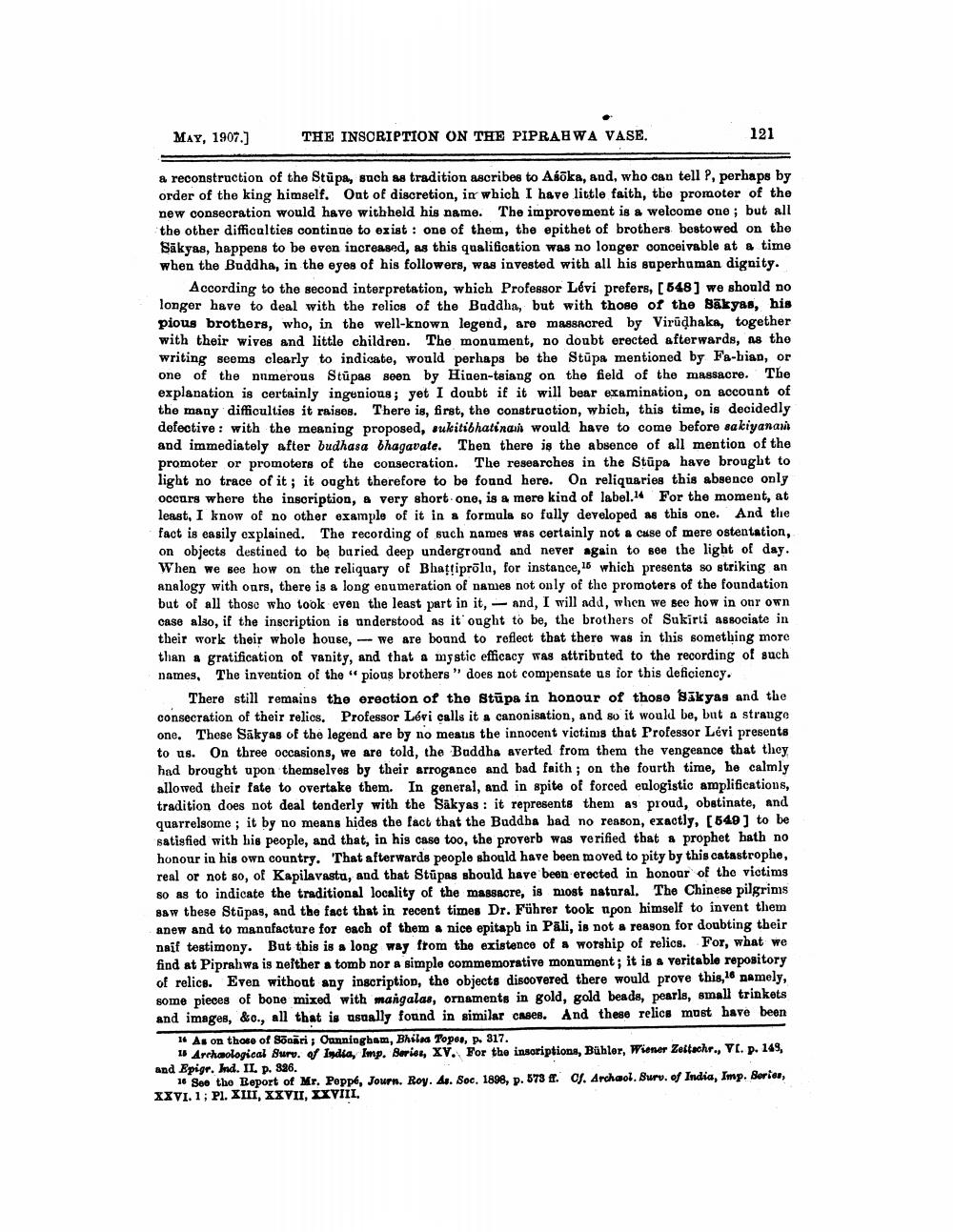________________
MAY, 1907.)
THE INSCRIPTION ON THE PIPRAHWA VASE.
121
a reconstruction of the Stupa, such as tradition ascribes to Asöka, and, who can tell P, perhaps by order of the king himself. Out of discretion, in which I have little faith, the promoter of the new consecration would have withheld his name. The improvement is a welcome one ; but all the other difficulties continue to exist : one of them, the epithet of brothers bestowed on the Sākyas, happens to be even increased, as this qualification was no longer conceivable at a time when the Buddha, in the eyes of his followers, was invested with all his superhuman dignity.
According to the second interpretation, which Professor Lévi prefers, [548) we should no longer have to deal with the rolios of the Buddha, but with those of the Bakyan, his pious brothers, who, in the well-known legend, are massacred by Virudhaka, together with their wives and little children. The monument, no doubt erected afterwards, as the writing seems clearly to indicate, would perhaps be the Stupa mentioned by Fa-bian, or one of the numerous Stūpas soon by Hinen-taiang on the field of the massacre. The explanation is certainly ingenious; yet I doubt if it will bear examination, on account of the many difficulties it raises. There is, first, the construction, wbich, this time, is decidedly defective : with the meaning proposed, sukitibhatinah would have to come before sakiyanasi and immediately after budhasa bhagavate. Then there is the absence of all mention of the promoter or promoters of the consecration. The researches in the Stūpa have brought to light no trace of it; it ought therefore to be found here. On reliquaries this absence only occurs where the inscription, a very short one, is a mere kind of label.14 For the moment, at least, I know of no other example of it in a formula so fully developed as this one. And the fact is easily explained. The recording of such names was certainly not a case of mere ostentation, on objects destined to be baried deep underground and never again to see the light of day. When we see how on the reliquary of Bhatriprola, for instance, 16 which presents so striking an analogy with ours, there is a long enumeration of names not only of the promoters of the foundation but of all those who took even the least part in it, — and, I will add, when we see how in our own case also, if the inscription is understood as it ought to be, the brothers of Sukirti associate in their work their whole house, -- we are bound to reflect that there was in this something more than a gratification of vanity, and that a mystic efficacy was attributed to the recording of such names, The invention of the pious brothers” does not compensate us for this deficiency.
There still remains the erection of the stūpa in honour of those Sakyas and the consecration of their relics. Professor Lévi calls it a canonisation, and so it would be, but a strange one. These Sākyas of the legend are by no meals the innocent victims that Professor Lévi presents to us. On three occasions, we are told, the Buddha averted from them the vengeance that they had brought upon themselves by their arrogance and bad faith ; on the fourth time, he calmly allowed their fate to overtake them. In general, and in spite of forced ealogistic amplifications, tradition does not deal tenderly with the Sakyas : it represents them as proud, obstinate, and quarrelsome; it by no means hides the fact that the Buddha bad no reason, exactly, (549) to be satisfied with his people, and that, in his case too, the proverb was verified that a prophet hath no honour in his own country. That afterwards people should have been moved to pity by this catastrophe, real or not so, of Kapilavasta, and that Stūpas should have been erected in honour of the victims 80 as to indicate the traditional locality of the massacre, is most natural. The Chinese pilgrims saw these Stūpas, and the fact that in recent times Dr. Führer took upon himself to invent them anew and to manufacture for each of them a nice epitaph in Pali, is not a reason for doubting their naif testimony. But this is a long way from the existence of a worship of relics. For, what we find at Piprahwa is neither a tomb nor a simple commemorative monument; it is a veritable repository of relics. Even without any inscription, the objects discovered there would prove this, 16 namely, some pieces of bone mixed with mangalas, ornaments in gold, gold beads, pearls, small trinkets and images, &o., all that is usually found in similar cases. And these relics must have been
14 As on those of Sõnari; Oanningham, Bhilas Topes, p. 317.
1 Arrhaological Surv. of India, Imp. Berish, xy. For the inscriptions, Bühler, Wiener Zeltachr., VL. p. 149, and Epigr. Ind. II. p. 826.
16 Soo the Boport of Mr. Peppé, Journ. Roy. As. Soc. 1898, p. 573 ft. of. Archaol. Burv. of India, Imp. Series, XXVI. 1; Pl. XIII, XXVII, XXVIII.




